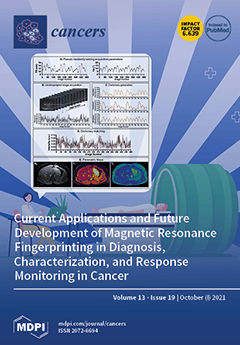Purpose: To evaluate the clinical outcomes of enlarged cardiophrenic lymph node (CPLN) in advanced-stage epithelial ovarian cancer (AEOC) patients who underwent cytoreductive surgery. Methods: The Embase, Medline, Web of Science, Cochrane Library, and Google Scholar databases were searched for articles from the database
[...] Read more.
Purpose: To evaluate the clinical outcomes of enlarged cardiophrenic lymph node (CPLN) in advanced-stage epithelial ovarian cancer (AEOC) patients who underwent cytoreductive surgery. Methods: The Embase, Medline, Web of Science, Cochrane Library, and Google Scholar databases were searched for articles from the database inception to June 2021. Meta-analysis was conducted to determine the prognostic impact of surgical outcome, postoperative complication, and survival using random-effects models. Results: A total of 15 studies involving 727 patients with CPLN adenopathy and 981 patients without CPLN adenopathy were included. The mean size of preoperative CPLN was 9.1± 3.75 mm. Overall, 82 percent of the resected CPLN were histologically confirmed pathologic nodes. Surgical outcomes and perioperative complications did not differ between both groups. The median OS time was 42.7 months (95% CI 10.8–74.6) vs. 47.3 months (95% CI 23.2–71.2), in patients with and without CPLN adenopathy, respectively. At 5 years, patients with CPLN adenopathy had a significantly increased risk of disease recurrence (HR 2.14, 95% CI 1.82–2.52,
p < 0.001) and dying from the disease (HR 1.74, 95% CI 1.06–2.86,
p = 0.029), compared with those without CPLN adenopathy. CPLN adenopathy was significantly associated with ascites (OR 3.30, 95% CI 1.90–5.72,
p < 0.001), pleural metastasis (OR 2.58, 95% CI 1.37–4.82,
p = 0.003), abdominal adenopathy (OR 2.30, 95% CI 1.53–3.46,
p < 0.001) and extra-abdominal metastasis (OR 2.30, 95% CI 1.61–6.67,
p = 0.001). Conclusions: Enlarged CPLN in preoperative imaging is highly associated with metastatic involvement. Patients with CPLN adenopathy had a lower survival rate, compared with patients without CPLN adenopathy. Further randomized controlled trials should be conducted to definitively demonstrate whether CPLN resection at the time of cytoreductive surgery is beneficial.
Full article






